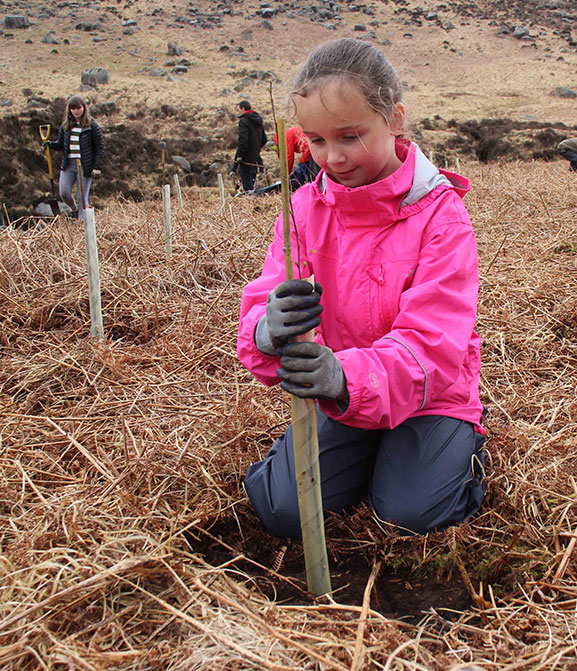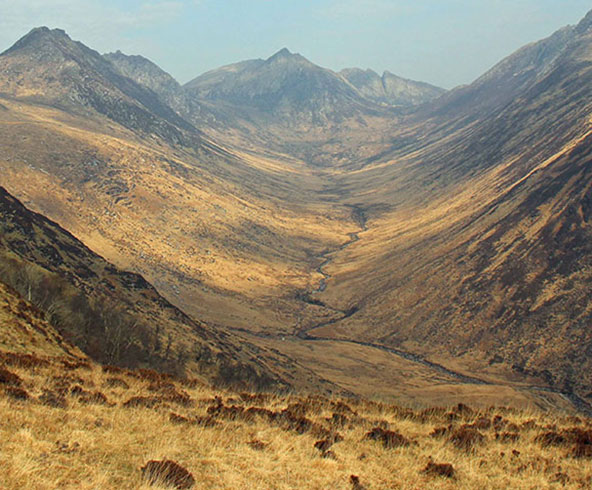We’re rescuing endangered and endemic species in Glen Rosa
A wildfire took hold in Glen Rosa on the Isle of Arran on the afternoon of Thursday 10th April and burnt over the weekend before being fully extinguished. We're still assessing the damage, but early surveys estimate that we've lost over 15,000 of our trees in the glen. Luckily, a few of our young, and extremely rare, whitebeams have survived.
Dedicating a Tree today will help us recover from the fire and repair the damage.
Promoting biodiversity
“Humans have had an impact on this glen for over 4,000 years and now we’re changing the environment too, but this time for conservation reasons. We’re not turning this landscape back to the way it was, instead we’re introducing trees that will increase biodiversity, we’re protecting endangered species and we’re futureproofing Glen Rosa. This time, human intervention will have a positive benefit for nature. Your support will help us achieve that.”
Kate Sampson | Head Ranger at Glen Rosa
The stunning glacier-carved valley of Glen Rosa in Arran has felt the impact of human intervention for over 4,000 years. Today, humans are intervening again, but this time positively, as we work to restore the woodlands we know existed on the lower slopes thousands of years ago and preserve three important species – the Arran whitebeam, cut-leaved whitebeam and Catacol whitebeam – all in danger of being lost forever.
We’re introducing downy birch, Sessile oak, hazel, willow, aspen and alder as well as our endangered and endemic Arran whitebeams to a 400-hectare site, fenced off to protect the young trees from grazing deer. Already, we’re seeing more insects, more birdlife and more native plant species return. By dedicating a tree in Glen Rosa, you’ll be making a vital contribution to the restoration of this stunning island landscape and the nature it supports.

Planting aspens in Glen Rosa
Our aim is to bring trees back to the glen for the first time in centuries, using naturalistic planting with mixed native species to significantly improve biodiversity and to protect natural habitats for wildlife such as red squirrels and golden eagles.
We have a specific focus on the conservation of three species – the Arran whitebeam, the cut-leaved whitebeam and the Catacol whitebeam. The three whitebeams are endemic to Arran and in danger of dying out without our intervention, and here is now only one Catacol whitebeam left in the wild here! Working with Edinburgh’s Royal Botanic Gardens, we’re gathering seeds to propagate these important species and ensure they will always have a home in this special glen.
Your donation will allow us to plant:
- Arran whitebeam
- Arran aspen
- Scottish oak
- Scottish hazel
- Downy birch
- Willow
- Alder
At the National Trust for Scotland, we want to connect people, plants and places, and our woodlands have a key part to play in this.
Your support will enable us to restore the woodland here and continue to develop our seed nursery, where it takes up to five years to grow one of the endangered endemic species from seed to sapling. You’ll help us to address:
-
Carbon capture to mitigate against climate change
Habitat regeneration
-
Reforestation
-
Native species protection
-
Increased biodiversity
-
Resilience
-
Landscapes and flooding
-
Water quality
In addition to your Dedicate a Tree certificate, you’ll receive a leaflet providing you with more information about the woodland you’re supporting and the trees we’re planting.
Every season, we’ll get in touch by email to update you on the impact of your support and we’ll share woodland videos, allowing you to follow the progress of your chosen woodland through the seasons.
When you’ve selected the woodland project you’d like to support, and confirmed your donation amount, we’ll invite you to leave a written dedication in the ‘virtual woodland’ on our website.
By doing so, you’ll not only be able to share your dedication with friends and family, you’ll also be joining a whole community of supporters who want to nurture and protect our wonderful woodlands.
Dedicate today to protect tomorrow
Woodlands and forests are often called ‘the lungs of the planet’. Through a process called woodland carbon sequestration, trees remove harmful carbon dioxide from the atmosphere and, by photosynthesis, release oxygen back while storing carbon within a natural reservoir of living biomass and soil. This makes trees our greatest allies in the battle against climate change and, by dedicating a tree, you’ll be helping us to restore and protect our vital woodlands for the benefit of everyone who loves Scotland now and in the future.
